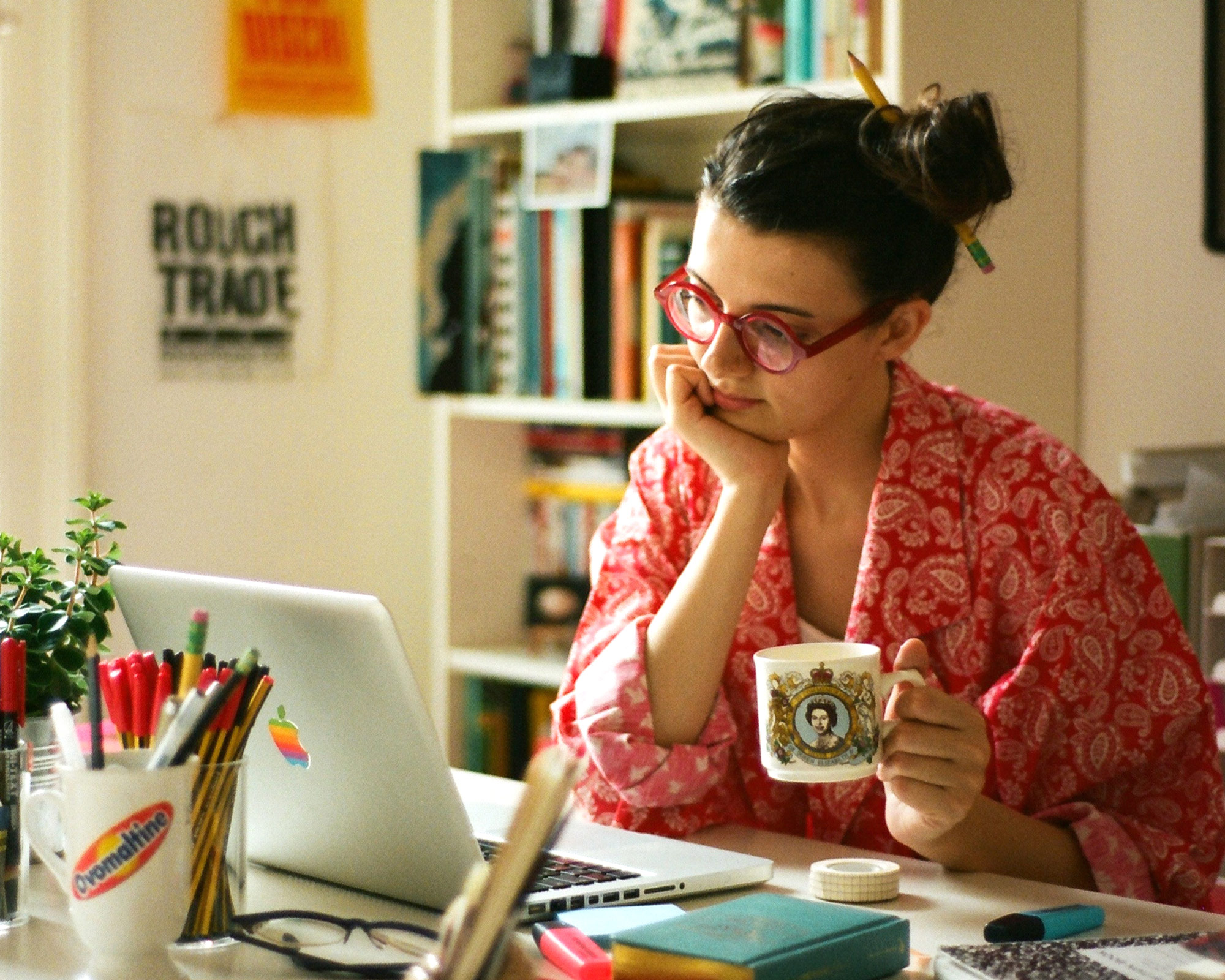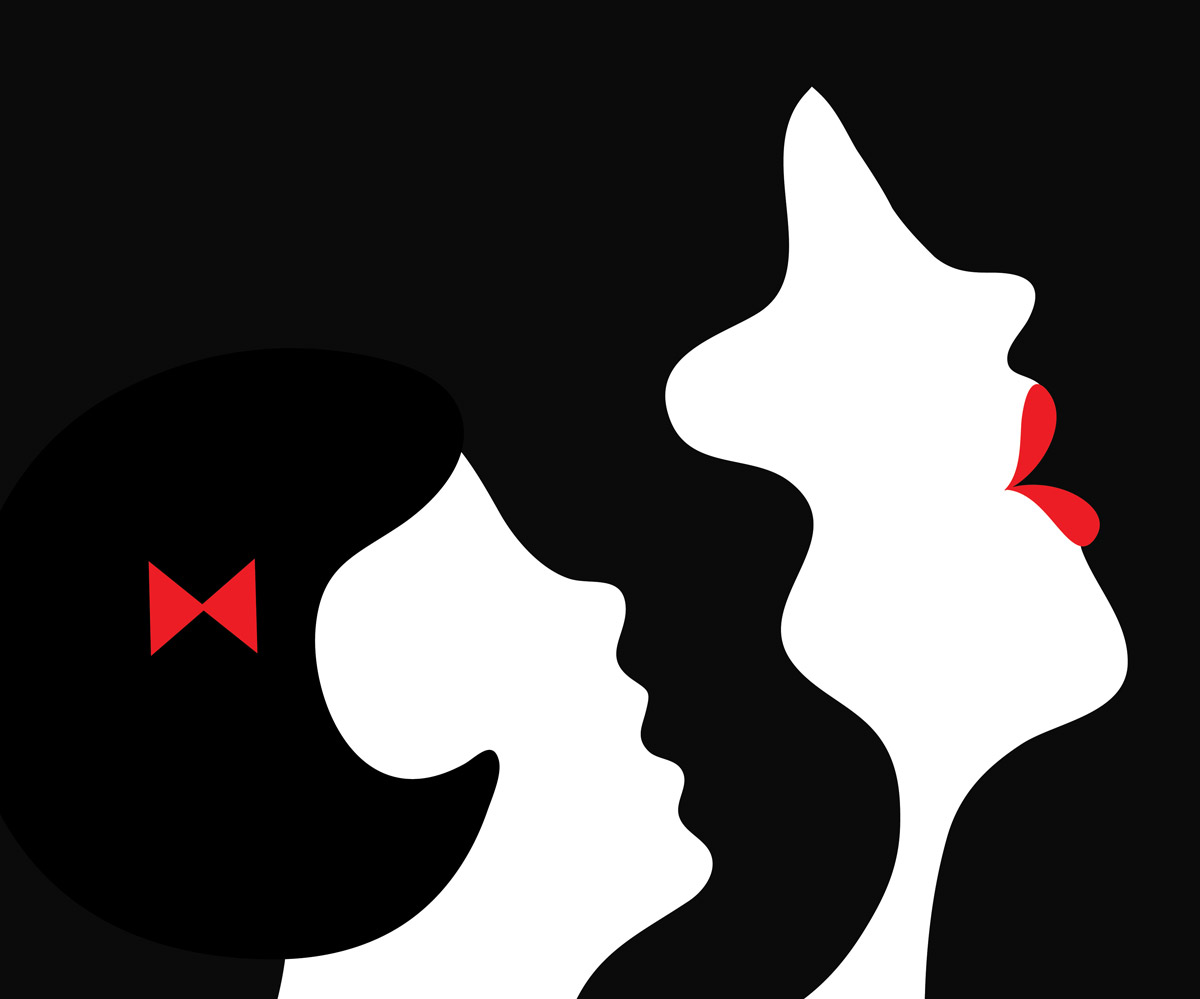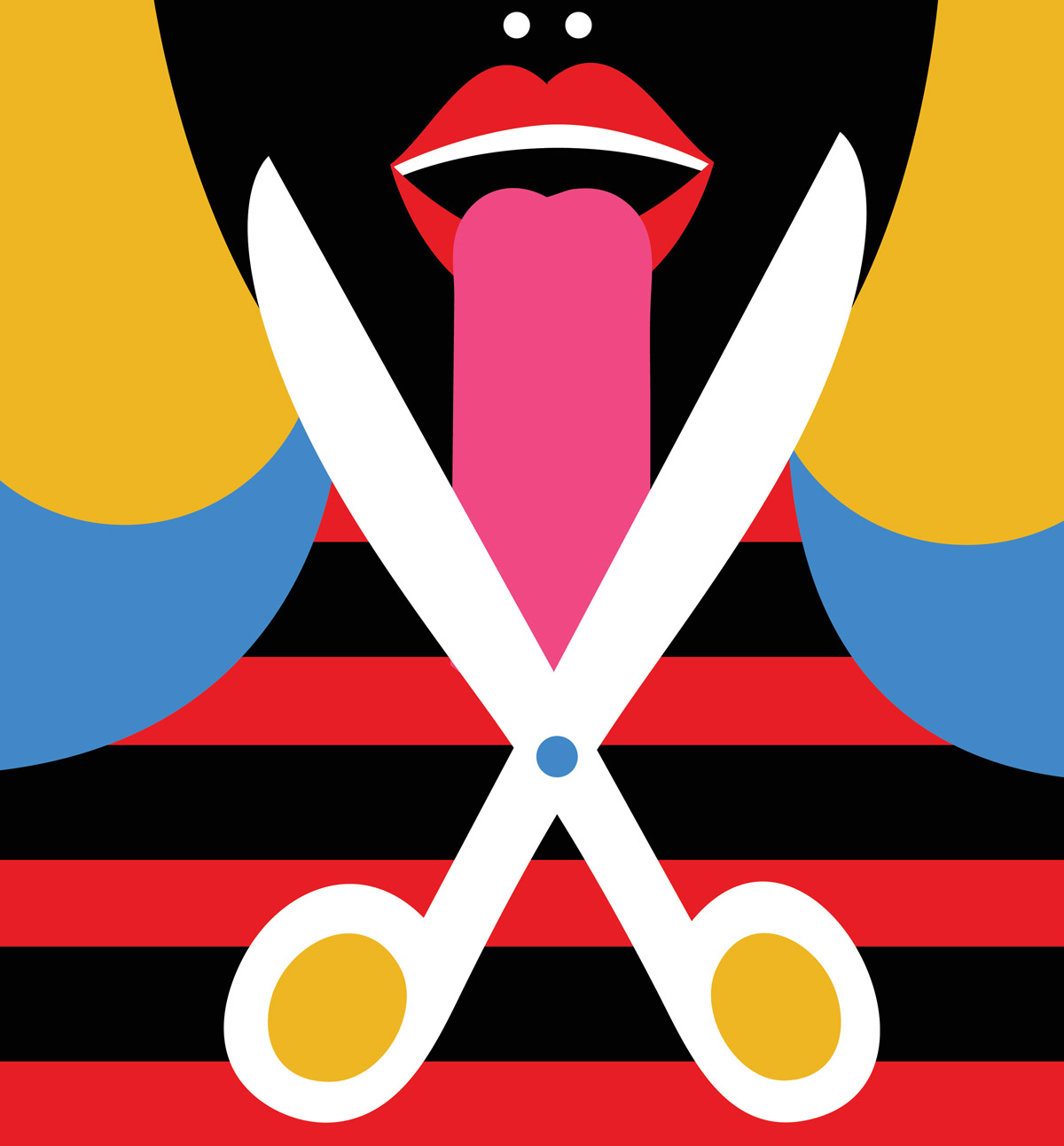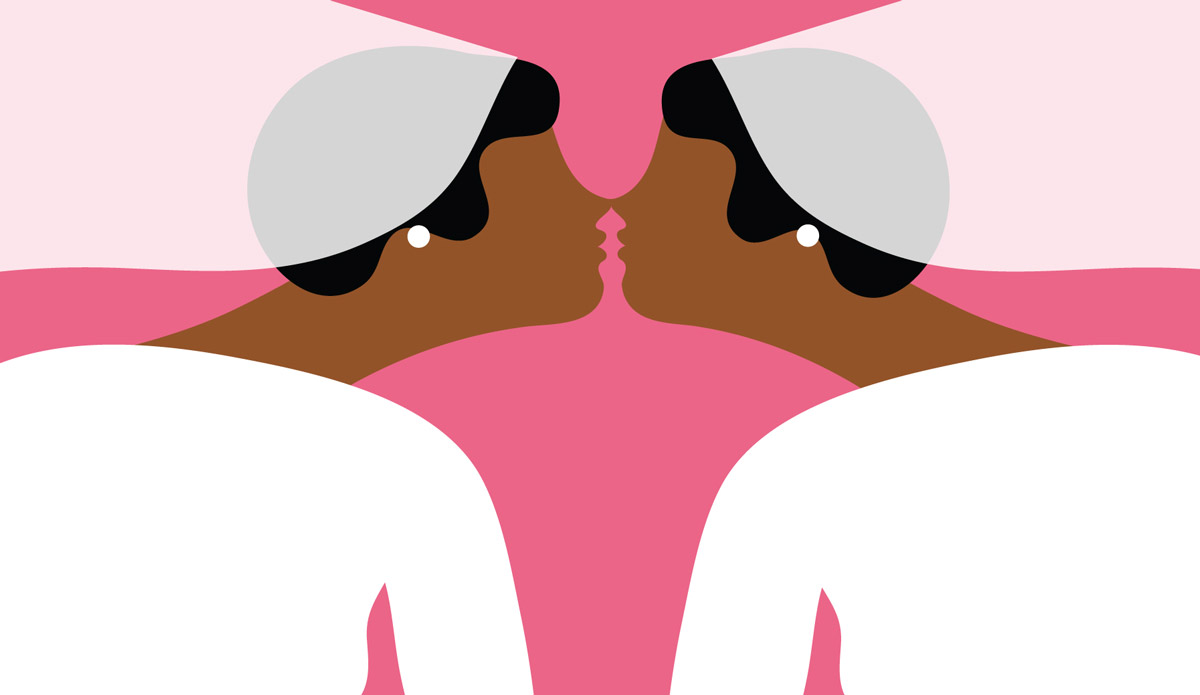
- Interview by Tina Essmaker March 5, 2013
- Photo by Claudia Zalla
Olimpia Zagnoli
- illustrator
Olimpia Zagnoli was born in 1984. After years of doodling, she became an illustrator and began collaborating with the New York Times, the New Yorker, Marie Claire, Rolling Stone, Taschen, and many others. Her style is characterized by soft shapes and chameleonic colors. She lives in Milan in a house with kaleidoscopic floors.
Interview
Describe your path to becoming an illustrator.
I started in a very liquid way. Since I was a kid, it was pretty normal for me to think about becoming whatever I wanted because I was lucky to have two artists as parents—my dad is a photographer and my mom is a painter. Nobody told me, but I knew from the beginning that I could be whatever I wanted and I never thought about making money or building a career—I just focused on what I liked, which was nice. I didn’t realize the decisions that others had to make until I was an adult and saw my friends being forced to find their own path, with their parents being very present in the process.
I started drawing at a young age; it was a good meditation for me. There were so many personalities and egos in the family because we’re all artists, so I needed to find my own space to make. In the beginning, it was the floor in my room where I would lay down and draw and invent stories for hours and hours.
Once I was attending middle school, I had to decide what I wanted to focus on for high school. Here, we have four choices of study: scientific, classical, linguistic, or artistic. I wanted to try the artistic track, but my mom thought the classical one would give me better basis for the future, so I ended up studying history, Latin, and Greek. Because of that, I didn’t have the chance to acquire the tools to draw, but I kept drawing on my own.
When I finished high school, I really wanted to keep drawing, so I went to an art school in Milan called Istituto Europeo di Design—the European Institute of Design. It was the only school that had a course in illustration back then and since it was in Milan, it was simple for me to go there while still living with my parents. Going there was good because I had to get organized and draw every day. On the other hand, the exercises were pretty boring and I wasn’t able to express myself how I wanted. When I graduated, I hadn’t developed a style. I knew what I liked, but I wasn’t able to talk in that language and translate what I had in my brain onto paper in the way that I wanted.
About a year after school, I started finding some satisfaction—not in terms of jobs, but in terms of finding a style and putting together a portfolio. As soon as I had a portfolio, I started contacting people. In Italy, Milan is the main city for editorial clients, so I started going to the newsstands and bookstores to see who I liked and then I tried to contact them. In the beginning, nobody responded to me no matter how hard I tried; I was nobody and no one wanted to give me a chance or take a risk on me.
I did do some very small works, but at some point, I decided I needed to try getting work somewhere else. That’s when I went to New York for the first time. I only had a few contacts in the US and somehow, I got the email of Brian Rea, who was the art director for the New York Times’ Op-Ed at the time. I emailed him, but was sure he wouldn’t respond. He gave me an appointment to come show him my portfolio and that’s how it started. Once I had images published in the US, it was a lot easier for me to get work here in Italy.
How long ago was that?
I think it was 2008.
That’s really interesting that your first big job was outside of Italy and was what helped you to get work in Italy.
I think my country is generally very scared of things that are new. The fact that another country like America responded to my work and approved of it was a sign that my work would be well-received in Italy, too. A lot of my colleagues have also had a similar experience.
Have you been freelancing since you graduated from college?
Yes, I have.
You talked about your path and really enjoying drawing from a young age, but did you have an “aha” moment when you realized that illustration was what you wanted to focus on as a career?
I didn’t really know what illustration was; I didn’t know the difference between being a painter and an illustrator. My mom was a painter and had to struggle with getting recognition in the art world and showing her work in galleries. Illustration seemed more connected to something that would give me the ability to actually pay my rent without having to care about being inside a specific scene. I didn’t consider myself an outsider when I was in high school, but I was into punk rock and books and was really in my own world: I didn’t view myself as an artist who could reach certain levels of popularity, so illustration seemed more appropriate for me. That way, I could keep my work private in journals and sketchbooks and enjoy it more.

“Even though I didn’t realize it when I was younger, I absorbed a lot from my parents. When I see their work, I see a very strong connection in terms of self-expression.”
Was creativity a part of your childhood?
I attended one of the kindergartens in Reggio Emilia, the city where I grew up for the first six years of my life. The method taught there is very popular and recognized in the rest of the world. It’s based on showing students different realities, stimulating their five senses, and creating a sense of community. Because it was in a small city close to the countryside, a lot of the experiences incorporated the surroundings and that was important to me because when I was six, my family moved to Milan and I became a city kid. My early experiences in kindergarten inspired my future life and I still recognize it as one of my most important creative experiences. I wish the rest of my schooling would have been as cool as that.
Did you have any mentors along the way?
I wouldn’t say I had official mentors. Even though I didn’t realize it when I was younger, I absorbed a lot from my parents. When I see their work, I see a very strong connection in terms of self-expression. I can’t call them mentors because they were just Mom and Dad, but they definitely meant a lot to me, which I realized once I became older and saw things with a certain distance.1
Apart from my parents, I had a couple people who helped me a lot in the process of becoming an illustrator and finding good connections in the industry in the US. One was Gary Taxali, who I met online. We started writing each other and he helped me a lot by introducing me to people and supporting my work from the very beginning when it was so horrible.
Another person is Steven Guarnaccia, Chair of the Illustration Program at Parsons. He also helped me a lot and was one of the first people I met in New York. I went to his studio and he told me he was really impressed because my work was speaking the language of our time, which is something I never thought about or considered.
I love Gary and Steven’s work and it was important to me to be recognized by them, especially because they weren’t the same age as me. I wouldn’t call them mentors, but they were definitely there for me when I needed help.
That’s cool. I think it’s really encouraging when someone who is established recognizes and affirms that there’s something great about your work or recognizes you and takes the time to help you out.
Was there a point when you took a big risk to move forward?
I don’t know. I think I’m always very positive and I don’t like to put myself in a situation where I have to suffer or make sacrifices. (laughing) I like to risk, but I like to make the risk comfortable. The biggest risk I’ve probably taken so far was becoming an illustrator, which could definitely be seen by some as an irresponsible choice, but at the end of the day, it’s the coolest job I know.

You’ve talked a lot about your family being supportive of you. Overall, are your friends and family supportive of what you do?
Yes. My friends always saw me drawing, but I’m not sure they thought I was going to do it for a job and I’m not sure they understand what I do or how I pay my rent. Being in Milan is not like being in New York where there is a big community of people who do what I do. Here, I never talk to or hang out with illustrators. It’s kind of good because I see things from a different perspective, but when I’m in New York, it’s also nice to feel that special connection with people who are like me.
Are you planning to stay in Milan? I only ask because you seem to like New York a lot.
Years ago, I was a lot more into the idea of moving to New York. I thought I needed to move there if I was going to be anyone, but then I moved out of my parent’s house and into my own place with my boyfriend and found a good balance. Now, I’m a lot more stable and I have a life here outside of my work. I like that my family and friends live pretty close to me. I’m free to go to NY whenever I like, but I also have a place to come back to. I don’t think I’m ready to leave everything behind and live in NY in the smallest apartment ever just to pursue my work. I do think it would be really helpful for my career to be there for a couple years and I would consider it as something I have to do for my career, but in general, I like to have these two realities that are really present in my life. When I’m here, I think about being in NY and when I’m in NY, I think about being here. I like the freedom of being able to be in both places, but we’ll see what happens.
Do you have a studio at home?
I have a room in my house that I use as a studio and for now, it’s working really well. I think it’s very comforting because I can take a break from working in the middle of the day and cook lunch, read a book, or do a dance.
Do you feel a responsibility to contribute to something bigger than yourself?
Unfortunately, what I do is create images and images don’t literally feed anyone, but perhaps they could feed someone’s eyes, which is a pretty big responsibility for a bunch of lines and colors. That’s why I always try to put my heart into my work and preserve my vision without compromising it.
Are you satisfied creatively?
Right now, I’m in a transition. If you asked me that question six months ago, I would have said yes. Now, I’m getting more interested in doing illustrations that aren’t necessarily connected to text and that aren’t too literal. What I like most is when an illustrator or artist can deliver an image that has a fingerprint on it, but could be used for a book cover or shirt or billboard, without needing text to explain it. What I would like to concentrate on more now is to make images that are strong and bold and don’t need to be in the cage of a grid. I would love to do something more universal.
I also admire artists from the past who made a lot of different things, from posters to products to textiles. I would love to go there in terms of creative processes. I enjoy and am so lucky to be doing this, but I’m getting a little tired of being an illustrator and using the same clichés over and over. I would love to create things that can just fly through the world without having to be connected to anything else.
Is there anything you want to try that you’re not doing now?
Oh yes! I like to try new things whenever I have the time. For example, I’ve been making music videos, which is a new thing. I’m not educated in that way, but I’m learning how it goes and trying to understand the process.
My dad and I have also started a shop together called Clodomiro. We started making products like plates and are going to make silk scarves next. I’m doing these things as experiments to see how I like to do different things and I hope that in 5 to 10 years, everything will become more clear. I like what I do, but I would like to do more; I think that’s a natural evolution of who you are as an artist. We’ll see what happens.
If you could give one piece of advice to a young illustrator starting out, what would you say?
Be different. Keep your eyes open. Record everything you see, process it, and then spit it back out in your own very personal way. Get inspired by something that’s not just illustration. Be serious. Be silly. Get drunk sometimes. Dream a lot. Don’t think you can’t do it, because you can.
You live in Milan. How does the city impact your creativity?
Milan is a nice city and even if it doesn’t have a great illustration scene, it does have a very big design and fashion scene, which is really inspiring.
Also, what I like about Milan is that it has an elegant and discreet side made up of old buildings, amazing architecture, and secret gardens that you would never expect to see in a city like this, which kind of surprises you. You have to find your own world of things you like and put them together like a little collage. Then, when you do that, you realize you’re turning into somebody who likes, or even loves, Milan.

“Be different. Keep your eyes open. Record everything you see, process it, and then spit it back out in your own very personal way. Get inspired by something that’s not just illustration.”
You said there aren’t a lot of illustrators there. Is it important to you to be part of a creative community of people and do you have that outside of illustration?
I pretty much hang out with musicians here because my boyfriend is a musician, my friends are musicians, and I grew up with kids who used to go to gigs every week. That’s the community I’m more connected to and it’s great because it gives me distance from work and when I go back to my studio, I find my little, untouched space. It’s good to not be inside of your niché all the time, talk about it all the time, and then go back to your studio and work on it all the time. But as I said before, It’s also very refreshing to know that there are places like New York where I can go out for a drink with colleagues and open up and talk about new projects and ideas. It’s still surprising for me to go to NY and see that a lot of people have been through what I’ve been through in terms of challenges or opportunities. It’s important to have both realities in my creative life.
That’s a good point. What does a typical day look like for you?
I wake up around 9am and go straight to my studio and start working. I don’t have a typical schedule; I’m pretty anarchist when it comes to work. There are days where I draw all the time and there are days where I answer emails all day and sketch a little. I usually stop doing everything around noon so that I can go to the kitchen and cook for my boyfriend and I. After lunch, we have coffee and then go back to our studios—he’s a musician, so he has to practice. We both keep working until 7–7:30pm and then I go back to the kitchen and make dinner. (laughing) The day is almost over by then and we’ll go out or watch a movie and then go to sleep. There are some days where I have to work at night, but overall, that’s pretty much the pattern of my life.
What music are you listening to right now?
I’m listening a lot to Velvet Underground and Lou Reed right now. I was in New York two weeks ago and I was walking around while listening to “New York” by Lou Reed. It’s fascinating how it sounded different there compared to how it sounds when I listen to it in Italy—like it belonged in NY and its notes were happy to be back home. I’m also listening to Brian Eno and I have my favorites: T. Rex, The Kinks, and Thin Lizzy.
Your favorite movie or TV show?
One of my all time favorites in terms of visual aesthetics is Mon Oncle by Jacques Tati. It’s a French movie from 1958 and has beautiful images and inspiring colors and scenes. French movies from that time are like candy. Have you ever seen Zazie dans le métro by Louis Malle? Naturally, I also love a good Italian movie. 8½ by Federico Fellini or Il giovedì by Dino Risi are some of the most loved. But I also like 1980s and 90s movies like The Goonies, Desperately Seeking Susan, True Romance, and Home Alone.
Your favorite book?
I know it may sounds pretty snobby, but it’s The Odyssey. I was really inspired by the book in high school and think that a lot of times, even if it’s not literal, I translate it into my work. Also, I still find traces of it in my dreams! I recently read Il Gattopardo (The Leopard) by Giuseppe Tomasi di Lampedusa, L’Ecume des jours (The Foam of Days) by Boris Vian, and The Wonderful Wizard of Oz by L. Frank Baum, which are all very inspiring in terms of visual suggestions.
Favorite food?
One of my favorite foods is my grandma’s tortellini, which is the dish she makes for Christmas and when the family gets together. It’s important for me because it not only means food, but it means my family will all be together. Being Italian, food is such a big part of my everyday life that it’s complicated to choose just one thing! If I had to pick a snack, I think it would be focaccia and estathé.
What kind of legacy do you hope to leave?
I think I would love to be remembered as a person who did something good. It doesn’t matter if that means becoming a great artist, being the mother of the best scientist on the planet, or inventing a new kind of pasta.